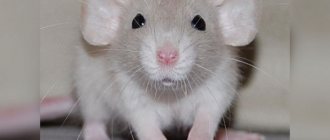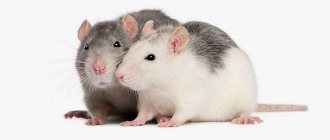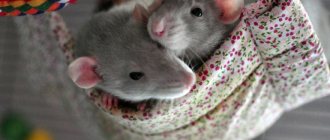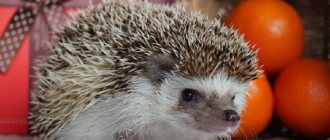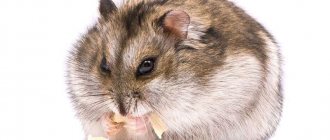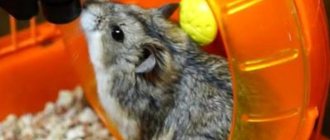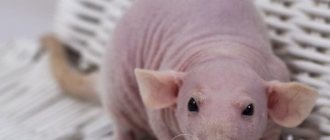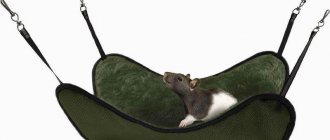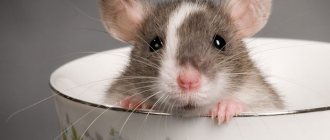The funny little elephant Dumbo from the American cartoon had such big ears that he could fly. Dumbo's rats have not been seen in aeronautics, but they have grown excellent ears. They are located lower on the head than in standard species, large, rounded. The amusing appearance of rodents has melted many human hearts and, although the breed has existed for only a short time - since 1991, its popularity is growing.
They bred Dumbo rats in California, fixing a random mutation that had happened before, just no one was interested in. The eared gene is recessive and parents with large ears do not necessarily have the same children. Popular colors are Siamese, pearl, topaz. But the most expensive is an exotic naked sphinx with wrinkled, velvety skin.
Types of decorative rats
There are different breeds of decorative rats. According to the type of wool they are divided into:
- standard, with short and smooth pile;
- rexes with mustaches and wavy fur;
- satin - with shiny silky fur;
- sphinxes are naked rats;
- Dumbo - individuals are distinguished by round, low-set ears, reminiscent of Mickey Mouse.
Animal colors are divided into subspecies:
- homogeneous: there are pure black, white, chocolate, blue, albino and others;
- heterogeneous: rats have Siamese, Himalayan, sable, silver and other colors;
- variegated: composed of several colors.
Types of domestic rats
This type of animal differs in size, coat color, and spots on the body. The most popular varieties are:
- standard;
- rex;
- satin rat;
- tailless rat;
- sphinx;
- downy;
- dumbo.
Standard is one of the popular breeds of domestic rats. The species was created by crossing white and gray rats. The color of this breed can be pure white or black and white. In rare cases, tri-colored rodents are found, with the presence of brown or gray. The eye color of this breed can be black, red or ruby. Adult rats have a maximum weight of 500 grams and reach a length of up to 20 cm.
The Rex is a unique species that has a coarse, curly coat. In addition to fur, this breed also has curly mustaches.
The satin rat is also called satin rat. Her fur is long, soft and shiny.
Tailless rats (Manx rats) are distinguished by the absence of hair on their tail.
Sphynx cats are very suitable for exotic lovers and those who do not like wool. Their lifespan is shorter than that of other species. Sphynx cats are highly susceptible to infectious diseases, which is why they require special care.
The downy rat has fine down, slightly curly whiskers, and may have hairless areas on its body.
Dumbo rats are distinguished by their large, rounded ears and may have similarities with other species. This could be a curly coat or no coat at all. The color of the coat can also be different.
Keeping decorative rats
Domestic decorative rats are rodents; they are cared for and kept in metal cages, because they are the strongest and most durable. It is better not to keep animals in plastic and wooden structures. It is also not recommended to place them in aquariums - they are difficult to clean, and the animals jump to a height of 40-50 cm and can escape. The house is installed in a place where there is no direct sunlight and draft, from which a rat can contract pneumonia. There is no need to place a home near the battery - dry air is harmful to animals. Optimum temperature +18-20°C.
For a decorative rat, the cage should have a size of 60x40x30 (for growth); often the house has two floors. Inside the home you need to install:
- a plastic tray with filler (preferably dry wood granules. Small sawdust can cause allergies in rats by getting into their eyes and nose. Newsprint contains harmful substances and is not suitable for use as bedding);
- stairs and tunnels, a wheel (animals love to play);
- plastic house for privacy;
- mineral stone for rodents (they sharpen their teeth);
- drinking bowl;
- 1-2 bowls;
- a cloth for sleeping or a hammock.
Why did they plant the pig?
The owner of one of the Chelyabinsk pet stores, Elena , admits that over the years that she has been selling guinea pigs, hamsters and mice, she has never gotten used to these animals. The passing year of the pig has increased the demand for guinea pigs. But, the woman says, she could still give them to the buyer with her bare hands when she sold them. Mice and rats are a different story. “I asked everyone who said that they were giving a guinea pig: why did you give people a pig? - the woman thinks. “Now I understand: okay, a pig, getting a rat will be much more offensive.” Elena admits: after having to deal with rats, showing customers how to feed and clean the cage, she feels like her whole body is dirty, fleas are crawling all over it, and out of disgust she wants to dive headfirst into the bath.
The seller recalls how she was given a live rabbit for New Year's 1999. This was also a symbol of the year according to the eastern calendar. The rabbit was small and cute, but literally after a few months he turned into a huge representative of the hare family. The small decorative rodent turned out to be... an ordinary rabbit. Somehow the woman managed to arrange a living gift for her friends in the village. She only asked not to tell her when Fedya would be eaten.
How to care for a decorative rat?
If decorative rats live in the house, care and maintenance of them include indispensable cleaning of the cage. Drinkers and bowls need to be washed daily, remove soiled or wet bedding, food debris, and change the filler in the tray. The cage and all household items must be systematically disinfected. If you carefully care for your decorative rat, the smell from it will be almost invisible. The animals are unpretentious and easily adapt to any environmental conditions. You can sometimes let them out for a walk, but you need to keep an eye on the pet so that it doesn’t chew on valuables.
Is it possible to bathe decorative rats?
Decorative domestic rats are neat and clean animals; keeping babies requires mandatory bathing. The procedure is carried out if the animal itches or has an unpleasant odor. Shampoo from a pet store will help deal with it. For bathing, prepare a container with heated water. They put the animal in it and wash it with their hands. In this case, the rodent may scratch and bite, but some people like this procedure. When bathing, you need to pay attention so that water does not get into the rat’s ears and nose. After the procedure is completed, the animal is dried with a towel.
Other varieties
Pasyuk
This is a fairly large rodent, weighing 250-600 grams. Unlike the domesticated form, the pasyuk has a convex forehead and well-defined brow ridges. The pasyuk's tail is thick and its length is shorter than the body. The ears are relatively small. Pasyuk is a homogeneous standard agouti.
Rat Pasyuk
Pasyukov can be kept at home, including together with a domesticated rat. Some nurseries infuse the blood of wild gray rats into domestic animals or breed only pasyuki.
Pasyuk retained most of his natural instincts. He easily accepts new experiences, thinks quickly and survives in the wild.
What to feed a decorative rat at home?
Care and maintenance of a rodent have its own nuances in nutrition. Although animals are unpretentious in food, their diet should contain as little fat as possible. Adults are fed 2 times a day, babies - 4 times. They also need clean and fresh water. What to feed a decorative rat at home:
- Grain base (wheat, oats, barley, corn, millet). High-quality balanced mixtures are sold in pet stores.
- Vegetables, fruits: white cabbage, carrots, bananas, cucumbers, apples, boiled potatoes, pumpkin, eggplants, grapes.
- Protein food (given once a week): a piece of boiled meat, cottage cheese, cheese, egg.
- Chicken bones: animals love to sharpen their teeth with them.
- In autumn and winter, it is recommended to give pets ready-made vitamins from a pet store.
Decorative rats - care and maintenance: what should not be given as food:
- chocolate, sweets, candies;
- raw beans or beans;
- smoked sausage;
- raw potatoes;
- chips;
- soda and sweet drinks;
- Brussels sprouts and red cabbage.
What grass can be given to decorative rats?
Greens should be present in the daily diet of rodents. What do decorative rats eat from grasses:
- dill;
- dandelion;
- parsley;
- cilantro;
- plantain;
- radish tops.
Decorative rats - diseases
A healthy animal is always active, it has clear eyes and shiny fur. There should be no red spots around the rodent's eyes, nose and ears. Knowing what a decorative rat looks like when properly cared for in a healthy state, if abnormalities are detected, you should consult a doctor. Rodent diseases:
- Excessive tooth growth. Occurs due to insufficient grinding and using only soft food - a veterinarian can help.
- Mycoplasmosis. A bacterial disease, infection occurs through the air, leading to pneumonia. It is almost impossible to save the animal.
- Abscesses. Abscesses appear on the skin, the doctor opens them, treats them, and administers the necessary medications.
- Tumors. They can be benign or malignant; the decision to remove them is made by the veterinarian.
- External parasites are mites. Appear from an excess of protein foods. It is necessary to remove seeds, nuts, meat from the diet, and clean the home daily for 1-2 weeks.
Maintaining a sanitary regime and ensuring a balanced diet are the main conditions for proper maintenance and care of the animal. Some infectious and parasitic diseases are also dangerous for humans, so you need to monitor the behavior and appearance of the animals and maintain personal hygiene. If your pet has lost its appetite, become less active, or looks unusual, it is important to contact a veterinarian.
How to tame a decorative rat?
Decorative rats have pros and cons in their character. The first include openness to communication and intelligence. As soon as a little rat appears at home, he is immediately given a name and addressed to him when food is poured in. After three days, the rodent begins to respond to the nickname and recognize the owner. Then you can gradually accustom him to holding hands. After the animal finally gets used to its owner, it is released to walk around the apartment. The disadvantage of a pet is the desire to chew on something - this must be controlled.
Dangerous diseases of domestic rats
Infectious and allergic diseases often overtake all rodents and rats are no exception. Most diseases can be cured without problems, but only if symptoms are treated immediately. There is a difference between a healthy and a sick animal, this can be seen in the fur and eyes. The animal's distinctive behavior and appearance indicate that it is sick and requires the help of a veterinarian
Most people like to keep animals at home, but not everyone is attracted to cats and dogs. In this case, a decorative rat would be an excellent option. This animal is smart, trainable, and with proper care you will not be deprived of affection.
Decorative rat - reproduction
Breeding of decorative rats is carried out using a pair of opposite-sex individuals aged 6 months. Girls weigh 200-400 g, they are nimble and neat. Boys - 450-600 g each, mostly clumsy and sloppy. The female's estrus repeats every 10 days. Mating is carried out for 1-4 hours in any territory - it does not matter with a girl or a boy. The female's pregnancy lasts 21 days, during which time she needs to eat more fruits and vegetables. Before giving birth, the expectant mother builds a nest - she drags out various materials (rags, toilet paper). The female gives birth to up to 8 rat pups weighing 5-7 g.
If a couple lives together, then at the time of birth the male must be separated so that he does not show aggression towards the babies. It is important for the mother in labor to have access to clean water so that she does not eat her offspring. The mother feeds the newborns for a month; from the third week of life they begin to try adult food. Babies' fur grows by 8-10 days, and their eyes open between 12 and 16 days. At the age of 1.5 months, the animals become completely independent and must be separated by gender or sold. After 12-18 months of life, females can no longer have offspring.
"Pushkin's rats"
The most terrible example of what the dominance of rats can lead to is a recent incident in Pushkin near Moscow. A mentally unstable, lonely woman kept a pair of different-sex decorative rats in her apartment. At first they lived without bothering anyone. But the irreparable happened: the owner, allowing them to reproduce, lost control over the rodents. Soon the woman’s neighbors sounded the alarm: the stench made it impossible to be in the entrance. The owner was taken away for compulsory treatment, but all that was left of her home was gnawed walls. The rats ate everything: food, plaster from the walls, shopping boxes, furniture. When the apartment was opened, rodents were absolutely everywhere. Neighbors and authorities wanted to carry out pest control, but animal rights activists intervened. They assessed the scale of the disaster: it was not possible to remove all the rodents at once; this process took place in several stages. About a thousand rodents went to be fostered by animal rights activists, who then moved permanently to rat lovers throughout the country. “Pushkin’s rats,” as animal rights activists called the rodents, acquired rare names and were seated in cages. On social networks, those rescuing rats from an apartment in Pushkin began their posts with the words: “SOS! Help is needed!" But they did not help to get rid of pests, but to save them and find “only the best kind hands.”
Related news
New Year 2020: prohibitions, history and traditions of the first of January in the year of the Rat
Training of decorative rats
There are many tricks that complement the natural habits of rodents and will bring pleasure to the owners. To do this, you will need a treat - a piece of meat, a pumpkin seed. How to train a decorative rat:
- Return to the cage. After the animal has taken root, it can be released for a walk around the apartment. It’s easy to return the animal: at the same time you need to sprinkle food, knock the bowl on the floor and call your pet - he will come running.
- “Sit” or “serve.” You need to hold the treat over the animal’s head and say the command. The rat will learn that it gets a treat after it stands on its hind legs and will follow the order to “sit” every time, even without a treat.
- Run in circles. You can move the treat along a trajectory and give it to the animal after it completes the trick. Also, with the help of treats, it is easy to teach a rat to run up stairs.
"Ugly, but loved"
Pet store, Chelyabinsk. Rats are sold for 500-1000 rubles. “Hurry up if you want to buy a rodent, they are in great demand this year, soon there will be nothing left!” — the saleswoman comments. At the same time, it is frankly admitted that not every person can be classified as a rat lover. But she does not dissuade those who come to buy a rodent as a gift: otherwise there will be no profit.
On free classifieds sites, rats are sold in huge quantities. It turns out that they, like other animals, have breeds! Some rodents have a pedigree, are expensive, and are given only to good hands. The gaze falls on one of the advertisements. They ask for two thousand rubles for a rodent.
I'm calling on the phone. The girl talks about the product: “Oh, she’s so disgusting, but loved. With a tuft on its body, which periodically comes out, and then pecks again. Unpretentious, lives in a cage, eats everything. Why am I selling? Because 7 of them were born, we need to put them somewhere.”
“My daughter got me hooked on rats,” said another rodent seller, Lyudmila . “We squeeze them all day long.” So cute and little. Little fluffy little ones. I even sometimes tell those who buy a rat from me that they can keep him alone, although they advise a flock of pairs. If you squeeze all the time, the rat will not get bored. They multiply with terrible force, I used to give them to friends, but now I decided to sell them: money, and no special hassle.”
Question answer
Can rat owners be reported?

